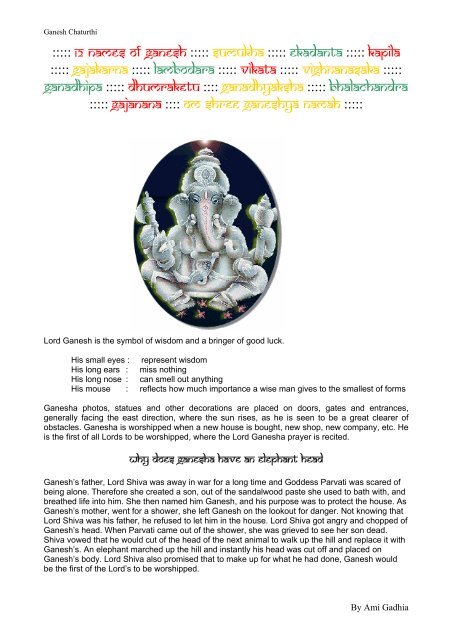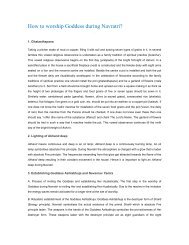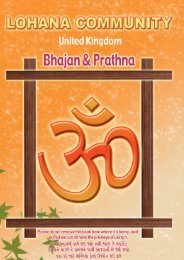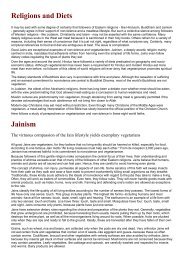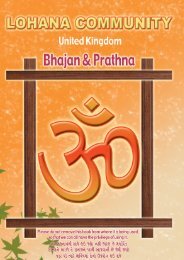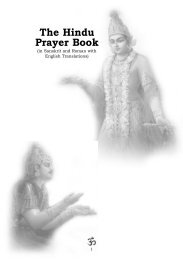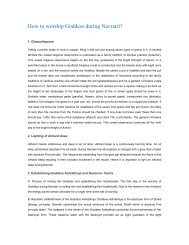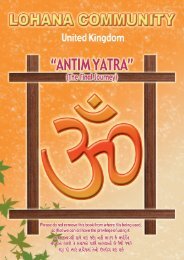Create successful ePaper yourself
Turn your PDF publications into a flip-book with our unique Google optimized e-Paper software.
<strong>Ganesh</strong> Chaturthi<br />
::::: <strong>12</strong> <strong>Names</strong> <strong>of</strong> <strong>Ganesh</strong> ::::: Sumukha ::::: Ekadanta ::::: Kapila<br />
::::: Gajakarna ::::: Lambodara ::::: Vikata ::::: Vighnanasaka :::::<br />
Ganadhipa ::::: Dhumraketu :::: Ganadhyaksha ::::: Bhalachandra<br />
::::: Gajanana :::: Om Shree <strong>Ganesh</strong>ya Namah :::::<br />
Lord <strong>Ganesh</strong> is the symbol <strong>of</strong> wisdom and a bringer <strong>of</strong> good luck.<br />
His small eyes : represent wisdom<br />
His long ears : miss nothing<br />
His long nose : can smell out anything<br />
His mouse : reflects how much importance a wise man gives to the smallest <strong>of</strong> forms<br />
<strong>Ganesh</strong>a photos, statues and other decorations are placed on doors, gates and entrances,<br />
generally facing the east direction, where the sun rises, as he is seen to be a great clearer <strong>of</strong><br />
obstacles. <strong>Ganesh</strong>a is worshipped when a new house is bought, new shop, new company, etc. He<br />
is the first <strong>of</strong> all Lords to be worshipped, where the Lord <strong>Ganesh</strong>a prayer is recited.<br />
Why does <strong>Ganesh</strong>a have an elephant head<br />
<strong>Ganesh</strong>’s father, Lord Shiva was away in war for a long time and Goddess Parvati was scared <strong>of</strong><br />
being alone. Therefore she created a son, out <strong>of</strong> the sandalwood paste she used to bath with, and<br />
breathed life into him. She then named him <strong>Ganesh</strong>, and his purpose was to protect the house. As<br />
<strong>Ganesh</strong>’s mother, went for a shower, she left <strong>Ganesh</strong> on the lookout for danger. Not knowing that<br />
Lord Shiva was his father, he refused to let him in the house. Lord Shiva got angry and chopped <strong>of</strong><br />
<strong>Ganesh</strong>’s head. When Parvati came out <strong>of</strong> the shower, she was grieved to see her son dead.<br />
Shiva vowed that he would cut <strong>of</strong> the head <strong>of</strong> the next animal to walk up the hill and replace it with<br />
<strong>Ganesh</strong>’s. An elephant marched up the hill and instantly his head was cut <strong>of</strong>f and placed on<br />
<strong>Ganesh</strong>’s body. Lord Shiva also promised that to make up for what he had done, <strong>Ganesh</strong> would<br />
be the first <strong>of</strong> the Lord’s to be worshipped.<br />
By Ami Gadhia
<strong>Ganesh</strong> Chaturthi<br />
Why does <strong>Ganesh</strong> have one tusk?<br />
Indra, the god <strong>of</strong> the skies, invited <strong>Ganesh</strong>a to a feast. Taking his vehicle (his mouse), <strong>Ganesh</strong>a<br />
began his journey to Indra’s palace. Because the mouse could not carry all his weight, he lost his<br />
balance and fell. The moon, shining in the night sky, laughed at him. Angered by this insult,<br />
ganesha broke <strong>of</strong>f his left tusk and threw it to the moon. And that’s why he may be called<br />
Ekadanta (means “with one tooth”). <strong>Ganesh</strong>a also cursed the moon “that whoever looked at the<br />
moon on the ganesh chaturthi night, they would undergo privations.” Even today, devotees avoid<br />
looking at the moon on ganesha days.<br />
A story <strong>of</strong> ganesh<br />
<strong>Ganesh</strong> had a brother called Kartikeya, who was very proud <strong>of</strong> his wisdom, speed and efficiency.<br />
He challenged <strong>Ganesh</strong> to a race around the world seven times. As Kartikeya made a tour <strong>of</strong> the<br />
world, <strong>Ganesh</strong>a simply walked around his parents, Lord Shiva and Goddess Parvati seven times,<br />
claiming victory. This shows the importance <strong>of</strong> God and parents in everyone lives.<br />
<strong>Ganesh</strong> Chaturthi<br />
This festival is the celebration <strong>of</strong> <strong>Ganesh</strong>’s birthday. However, it is celebrated in a very different<br />
way. It comes on the 4 th day on the bright half <strong>of</strong> the month Bhadarvo. Months in advance, the<br />
excitement and enthusiasm begins, as models <strong>of</strong> <strong>Ganesh</strong> are being made in different poses<br />
(according to research, there are 91 poses that <strong>Ganesh</strong>’s murti’s can be found in), colours and<br />
sizes. They are usually made in Bombay, Pune and Pen. Then they are <strong>of</strong>ten imported to other<br />
countries or villages. These are used for worship in houses and temples from one to ten days,<br />
depending on the family’s tradition. Indian sweets are made, containing coconut and sugar. They<br />
are shared with friends and family on the day <strong>of</strong> <strong>Ganesh</strong> Chaturthi.<br />
By the fifth day, idols <strong>of</strong> Gauri and Parvati are also in houses for worship. The ganesha idols can<br />
be immersed into the seas before midnight on the 2 nd , 5 th , 7 th or 11 th days led by a procession <strong>of</strong><br />
music, bells and drums. The whole village gathers around, and farewells Lord <strong>Ganesh</strong>a into the<br />
waters. It is a very emotional moment and like the phoenix, he will rise again next year.<br />
The <strong>Ganesh</strong>ya puja<br />
A <strong>Ganesh</strong>a puja is also carried out on this day. It involves preparing a corner <strong>of</strong> the house, to<br />
welcome <strong>Ganesh</strong>. “Panchamrut” is prepared, this is a liquid made out <strong>of</strong> the five nectars, milk,<br />
curd, ghee, honey and sugar or sakar. Both, with water is used to cleanse the murti <strong>of</strong> <strong>Ganesh</strong>. He<br />
is then given red clothing and a sacred thread. He is then covered with red sandalwood paste,<br />
<strong>of</strong>fered red & yellow flowers. The diva lamp is lit, the bells chime and he is <strong>of</strong>fered food in six<br />
symbolic mouthfuls.<br />
This puja is performed twice a day, morning and evening. Touching the idol with the blades <strong>of</strong><br />
Durva grass, he is brought to life step by step, going through the 15 out <strong>of</strong> 16 rites <strong>of</strong> passage that<br />
Hindus go through in their lifetime (16 th being for death). The puja ends as a mantra and the<br />
<strong>Ganesh</strong>ya prayer is chanted. The family gathers around and rice grains are placed on his head,<br />
then moving the idol so he is unseated.<br />
May the blessings <strong>of</strong> Sri <strong>Ganesh</strong>a be upon you all!<br />
May He remove all the obstacles that stand in your spiritual path!<br />
May He bestow on you all material prosperity as well as liberation!<br />
By Ami Gadhia


